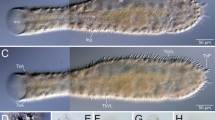Summary
-
1.
Differentiations in the protonema of Funaria hygrometrica are greatly influenced by substances which the protonema itself releases into the substrate.
-
2.
The radial symmetric field of diffusion of these substances causes the “fairy ring”.
-
3.
Factor H is the first of these morphogenetic substances produced by the protonema to be isolated from the substrate. This factor may be considered as a hormone and is responsible primarily for the bud-formation in caulonema. The inhibition of caulonema growth is a secondary effect of factor H and therefore of subordinate importance; in any case, this effect shows no direct correlation to the induction of bud formation. Factor H is first released into the substrate at the beginning of caulonema differentiation. Later on it can be obtained by suspending some protonema in nutrient solution.
-
4.
Factor H is stable at 100°C and is soluble in water, butyl alcohol, amyl alcohol and ethyl acetate. In the presence of water the solubility in ethyl acetate depends on the pH of the solution. Factor H is easily soluble at pH 2-7, soluble at pH 7–9 and insoluble at pH values above 9. At pH 3–9, factor H exists as a cation and therefore it can be purified by electrophoresis or by cation-exchange chromatography.
Zusammenfassung
-
1.
Differenzierungsvorgänge am Protonema von Funaria hygrometrica stehen weithin unter dem Einfluß von Substanzen, die das Protonema im Laufe seiner Entwicklung an das Substrat abgibt.
-
2.
Das radiärsymmetrische Diffusionsfeld dieser Substanzen ist die Ursache des Hexenringphänomens.
-
3.
Faktor H ist der erste im Substrat greifbar gewordene Vertreter solcher protonemaeigener Morphoregulatoren. Er hat Hormoncharakter und ist in erster Linie für die Entstehung der Knospen am Caulonema verantwortlich. Die Caulonemahemmung ist eine Nebenwirkung des Faktor H von untergeordneter Bedeutung; jedenfalls steht sie in keiner unmittelbaren Beziehung zur Knospeninduktion. Faktor H wird vom Protonema frühestens mit Beginn der Caulonemadifferenzierung an das Substrat abgegeben. Danach kann er durch Suspendieren von Protonemen in Nährlösung erhalten werden.
-
4.
Faktor H ist stabil bei 100°C, löslich in Wasser, Butanol, Amylalkohol und Essigsäureäthylester. Bei Gegenwart von Wasser ist die Löslichkeit in Essigsäureäthylester vom pH-Wert der wäßrigen Lösung abhängig: sehr leicht löslich bei pH 2-7, löslich im pH-Bereich 7–9, darüber unlöslich. Im pH-Bereich 3–9 liegt Faktor H als Kation vor und kann durch Elektrophorese oder Chromatographie an Kationenaustauschern gereinigt werden.
Mein verehrter Lehrer, Herr Prof. Dr. Martin Bopp, hat diese Arbeit jederzeit großzügig unterstützt und in anregenden Diskussionen gefördert; dafür möchte ich ihm auch an dieser Stelle recht herzlich danken. Frau Karin Blase gilt mein Dank für gewissenhafte technische Assistenz.
Similar content being viewed by others
Literatur
Bauer, L.: Isolierung und Testung einer kinetinartigen Substanz aus Kalluszellen von Laubmoossporophyten. Z. Pflanzenphysiol. 54, 241–253 (1966).
Bopp, M.: Versuche zur Analyse von Wachstum und Differenzierung des Laubmoosprotonemas. Planta (Berl.) 53, 178–197 (1959).
—: Development of the protonema and bud formation in mosses. J. Linnean Soc. Bot. 58, 305–309 (1963).
—: Die Morphogenese der Laubmoose als Beispiel eines morphogenetischen Systems. Ber. dtsch. bot. Ges. 78 (44)-(54) (1965).
—, u. H. L. Böhrs: Versuche zur Analyse der Protonemaentwicklung der Laubmoose. III. Die Regeneration der Caulonemen von Funaria hygrometrica. Planta (Berl.) 67, 357–374 (1965).
Bopp, M., u. H. Brandes: Versuche zur Analyse der Protonemaentwicklung der Laubmoose. II. Über den Zusammenhang zwischen Protonemadifferenzierung und Kinetinwirkung bei der Bildung von Moosknospen. Planta (Berl.) 62, 116–136 (1964).
—, H. Jahn u. B. Klein: Eine einfache Methode, das Substrat während der Entwicklung von Moosprotonemen zu wechseln. Rev. bryol. lichén. 33, 219–223 (1964).
—, u. B. Klein: Versuche zur Analyse der Protonemaentwicklung der Laubmoose. I. Endogene Wachstumsregulatoren im Protonema von Funaria hygrometrica. Port. Acta Biol. A 7, 95–110 (1963).
—, u. E. Stehle: Zur Frage der Wasserleitung im Gametophyten und Sporophyten der Laubmoose. Z. Bot. 45, 161–174 (1957).
Brandes, H.: Der Wirkungsmechanismus des Kinetis bei der Induktion von Knospen am Protonema der Laubmoose. Planta (Berl.) (im Druck 1967).
Ernst, M.: Entwicklungsphysiologische Untersuchungen an Mutanten von Funaria hygrometrica. Diss. Freiburg 1958.
Fries, K.: Über einen genuinen keimungs- und streckungswachstumsaktiven Hemmstoff bei Marchantia polymorpha L. Beitr. Biol. Pflanz. 40, 177–235 (1964).
Heitz, E.: Moosmutationen. I. Spontane und druch Colchicin ausgelöste polyploide Mutanten bei Aulacomnium androgynum (L.). Arch. Klaus-Stift. Vererb.-Forsch. 20, 120–125 (1945).
Jahn, H.: Die Wirkung von Blaulicht und Kinetin auf die Protonemenentwicklung und Knospenbildung von Funaria hygrometrica. Flora (Jena) 155, 10–29 (1964).
Klein, B.: Über den Einfluß von Aktivkohle auf die Protonemaentwicklung von Funaria hygrometrica. In Vorbereitung.
Löffler, H.: Untersuchungen der Knospenbildung von Funaria hygrometrica Sibth. unter besonderer Berücksichtigung der Wirkung von Kinetin und von Blaulicht. Diss. Freiburg 1962.
Mitra, G. C., A. Allsopp, and P. F. Wareing: I. The effects of light of various qualities on the development of the protonema and bud formation in Pohlia nutans (Hedw.) Lindb. Phytomorphology 9, 47–54 (1959).
—, Misra, L. P., and C. Prabha: Interaction of red and blue light on the development of the protonema and bud formation in Pohlia nutans. Planta (Berl.) 65, 42–48 (1965).
Pringsheim, E., u. O. Pringsheim: Physiologische Studien an Moosen. III. Jb. wiss. Bot. 82, 311 (1935).
Schmucker, Th.: Ökologie. In: Fortschritte der Botanik, Bericht über das Jahr 1961. Berlin-Göttinge-Heidelberg: Springer 1962.
Scutt, J. E.: Autoinhibitor production by Chlorella vulgaris. Amer. J. Bot. 51, 581–584 (1964).
Wolters, B.: Über Wechselbeziehungen zwischen Moosen und Algen in Reinkultur unter Berücksichtigung der Antibiose. Arch. Mikrobiol. 37, 293–326 (1960)
— Antibiotisch und toxisch wirkende Substanzen aus Algen und Moosen. Planta med. (Stuttg.) 12, 85–99 (1964a).
— Die Verbreitung antifungaler Eigenschaften bei Moosen. Planta (Berl.) 62, 88–96 (1964b).
Author information
Authors and Affiliations
Additional information
Stark gekürzte Fassung des I. Teiles einer Dissertation an der Fakultät für Natur- und Geisteswissenschaften der Technischen Hochschule Hannover.
Rights and permissions
About this article
Cite this article
Klein, B. Versuche zur Analyse der Protonemaentwicklung der Laubmoose. Planta 73, 12–27 (1967). https://doi.org/10.1007/BF00419837
Received:
Issue Date:
DOI: https://doi.org/10.1007/BF00419837




